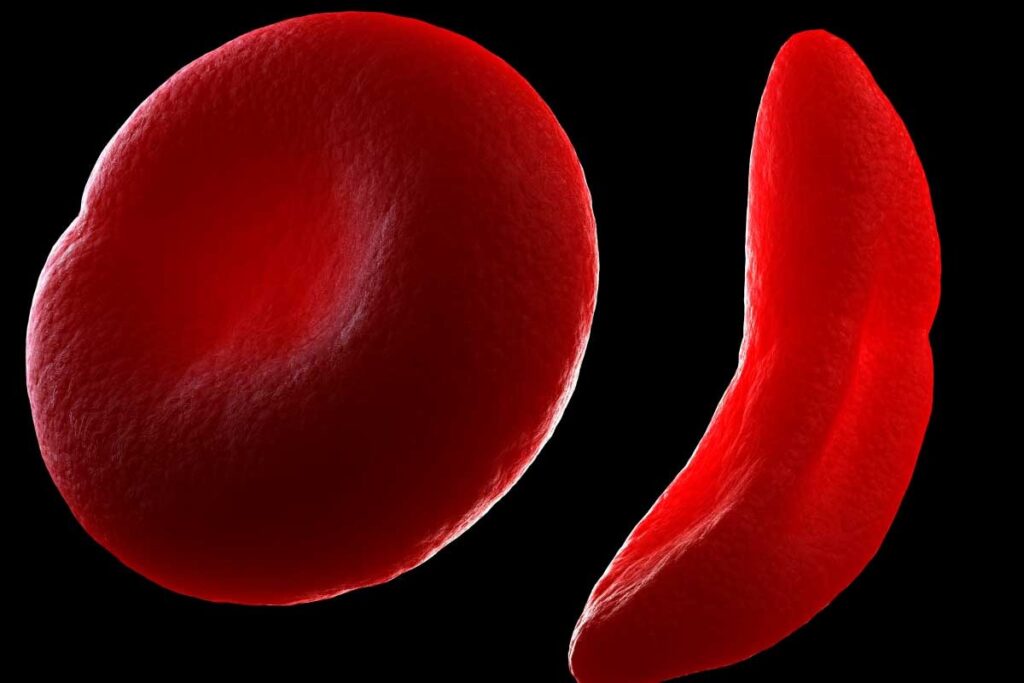
At Liv Hospital, we know finding sickle cell disease in newborns and infants is hard. But it’s very important for their health. Signs like yellow eyes and swollen hands or feet might not be easy to spot at first.
As a caregiver, knowing these early signs is key. By 5-6 months, symptoms like painful swelling and frequent infections can show up. Catching it early helps manage the disease and avoid serious problems.
We aim to give top-notch healthcare and support to patients from around the world. Our team focuses on safety, quick diagnosis, and improving care for kids with sickle cell disease.

It’s key to spot sickle cell disease early. This genetic disorder messes with how red blood cells make hemoglobin. We’ll look at its causes, how it shows up in babies, and risk factors.
Sickle cell disease comes from a gene mutation. This mutation makes abnormal hemoglobin, or sickle hemoglobin. If a person gets two copies of this gene, they might get sickle cell disease. Red blood cells become crescent-shaped, which can block blood flow.
“Sickle cell disease is a genetic disorder that affects hemoglobin production, causing red blood cells to be misshapen and leading to various health complications.”
Babies with sickle cell disease might not show symptoms right away. This is because they have fetal hemoglobin that protects them. But as they grow and fetal hemoglobin goes down, symptoms start to show. Infants are more at risk for infections and other problems because their immune systems are not fully developed. The disease can lead to pain, anemia, and serious health issues.
Sickle cell disease is common in some groups, like Africans, Caribbeans, and people from the Middle East. If both parents carry the mutated gene, their child is at higher risk. Genetic counseling and prenatal tests can find carriers and affected fetuses. Knowing these risks helps with early diagnosis and care.
It’s vital to spread awareness about sickle cell disease, mainly in high-risk groups. By knowing the causes, signs, and risks, we can improve care for babies and their families.

Symptoms of sickle cell disease usually show up in the first few months of life. This genetic disorder affects how red blood cells make hemoglobin. It makes them sickle-shaped under certain conditions. Babies with sickle cell disease often don’t show symptoms right after birth. But, as they grow, symptoms can start to appear.
Newborns with sickle cell disease don’t show symptoms right away. This is because their red blood cells have a lot of fetal hemoglobin. Fetal hemoglobin doesn’t get sickled by the disease. As the amount of fetal hemoglobin goes down, symptoms start to show up.
Symptoms of sickle cell disease usually start around 5-6 months old. But, this can vary a lot from one baby to another. Some might not show symptoms for months longer. Many things can affect when symptoms start, like how much fetal hemoglobin is left and any health issues.
| Age Range | Typical Symptoms |
| 0-3 months | Often asymptomatic |
| 4-6 months | Initial symptoms may appear, such as anemia or dactylitis |
| 6+ months | Increased frequency of sickle cell crises |
Some things can make symptoms show up sooner in babies with sickle cell disease. Infections, dehydration, and extreme temperatures can cause crises. Babies with less fetal hemoglobin might also show symptoms earlier.
It’s important for parents and doctors to watch these babies closely. Regular check-ups and care can help manage the disease. This improves the life quality for babies with sickle cell disease.
Infants with sickle cell disease may show different skin changes. These signs are important for parents and doctors to notice.
Pallor, or pale skin, is a common sign in infants with sickle cell disease. It happens because of anemia, which means not enough red blood cells. Anemia is a key part of sickle cell disease, and pallor shows it. You can see it in the lips, nail beds, and inner eyelids.
Jaundice is another big skin change. It makes the skin and eyes look yellow. This happens because of broken-down red blood cells, a result of sickle cell disease. This breakdown leads to a buildup of bilirubin, causing the yellow color. Jaundice is a common sign in sickle cell disease and is a big concern.
When talking about sickle cell anemia yellow eyes, jaundice is a big worry. It can cause yellow eyes, which means a child needs to see a doctor.
Besides pallor and jaundice, infants with sickle cell disease might have other skin issues. These can include rashes or lesions, but they’re not as common. It’s key for parents to watch their child’s skin for any odd changes and talk to their doctor. The question of does sickle cell cause yellow eyes shows how important it is to know how the disease affects the body.
In short, skin changes are a big deal in sickle cell disease for newborns and infants. Spotting these signs early can help diagnose and treat the condition sooner.
Infants with sickle cell disease show clear signs that need quick action. These signs help doctors diagnose and treat the condition early.
Dactylitis, or hand-foot syndrome, is a common sign in sickle cell disease babies. It causes hands and feet to swell painfully. This can be very distressing and is often one of the first symptoms noticed. It’s vital to quickly treat dactylitis to ease pain and avoid further problems.
Sickle cell disease can slow down a baby’s growth and development. Kids with it might grow slower because of chronic anemia and other issues. It’s important for doctors to keep a close eye on these babies to catch any problems early.
Anemia is a key sign of sickle cell disease. Babies might look pale because of low hemoglobin. They could also have jaundice, which is yellow skin and eyes from broken-down red blood cells. These signs show the disease’s impact on a baby’s health.
Spotting these signs early is key to managing sickle cell disease well. We stress the need for careful watching and quick medical help to help these babies thrive.
It’s important to know the signs of discomfort in infants with sickle cell disease. This helps in early treatment and care. Infants may show certain behaviors that show they are in pain or uncomfortable.
Infants with sickle cell disease often seem irritable and fussy. This is because of the pain they feel. Caregivers might notice the infant is more upset than usual, and this can last a long time.
It’s key to tell normal fussiness from fussiness caused by sickle cell disease. Keeping a diary of the infant’s behavior can help spot patterns and what might upset them.
Infants with sickle cell disease may have trouble feeding and sleeping. This is because they are uncomfortable or in pain. It makes it hard for them to eat or sleep well.
Feeding problems can worry about the infant’s nutrition and health. Monitoring feeding patterns and ensuring adequate nutrition is very important. Sleep issues can also affect the infant and the caregiver’s well-being.
| Signs | Description | Potential Action |
| Irritability | Increased fussiness and crying | Check for pain, offer comfort |
| Feeding Disturbances | Difficulty feeding, refusal to feed | Monitor feeding, ensure adequate nutrition |
| Sleep Disturbances | Difficulty sleeping, frequent waking | Establish a bedtime routine, create a sleep-friendly environment |
Finding pain in pre-verbal children is hard. But, there are signs caregivers can look for. These include changes in behavior, facial expressions, and body language.
Caregivers need to be alert and work with doctors to manage the infant’s pain. Knowing these signs helps in giving the right care and comfort to the infant.
It’s important to know what sickle cells look like to diagnose and manage sickle cell disease in babies. This disease affects how red blood cells make hemoglobin, leading to an abnormal shape.
Under a microscope, sickled red blood cells look like crescents or C-shapes. They are different from the normal disk-shaped cells. This shape change happens because of abnormal hemoglobin, known as hemoglobin S.
This shape makes it hard for these cells to move through blood vessels. This leads to various problems. We’ll see how this shape causes symptoms next.
The crescent shape of sickled red blood cells causes them to get stuck in small blood vessels. This leads to several symptoms. Some key issues include:
Blood tests are key for diagnosing sickle cell disease in babies. Some common findings are:
These tests help doctors find sickle cell disease early. This allows for early treatment and management to prevent further problems.
Infants with sickle cell disease face serious complications early on. These issues can greatly affect their health and growth. It’s vital to catch and manage these problems early.
Infants with sickle cell disease are more likely to get infections. Their young immune systems and spleen issues make them vulnerable. Look out for fever, irritability, and changes in feeding habits. If you see these signs, get medical help right away.
It’s important for parents and caregivers to work with their doctor. They should plan how to watch for and handle infections in these babies.
Acute chest syndrome is a serious issue in sickle cell disease, even in infants. It shows up as a new lung problem on X-rays, often with fever, cough, or trouble breathing. This condition is very serious and needs quick medical care.
Spotting acute chest syndrome can be hard because its signs are subtle. But catching it early and treating it fast is key to avoiding serious damage and improving the baby’s chances.
Splenic sequestration crisis is another serious problem in sickle cell disease babies. It happens when red blood cells get stuck in the spleen, causing a drop in hemoglobin and severe anemia.
Look for sudden spleen growth, paleness, and tiredness. Quick medical help is needed to handle this crisis effectively.
| Complication | Signs and Symptoms | Immediate Action |
| Infection | Fever, irritability, changes in feeding | Seek medical attention |
| Acute Chest Syndrome | Fever, cough, difficulty breathing | Immediate medical attention |
| Splenic Sequestration Crisis | Splenomegaly, pallor, lethargy | Prompt medical attention |
Knowing about these early problems in sickle cell disease is key to helping these babies. By spotting signs early and getting medical help fast, we can help them stay healthy and grow well.
Early detection of sickle cell disease through newborn screening is key. Newborn screening programs aim to spot sickle cell disease soon after birth. This early detection allows for timely care.
Newborn screening for sickle cell disease is a simple blood test. It’s done when the baby is between 24 and 48 hours old. The test looks for abnormal hemoglobin, a sign of sickle cell disease.
The screening process is vital. It helps healthcare providers spot babies who need more testing or early care.
Screening test results show if a newborn has sickle cell disease, is a carrier, or has normal hemoglobin. It’s important for parents to understand these results and their child’s health implications.
Receiving a diagnosis of sickle cell disease can be tough. But knowing about the condition and its management can help families cope.
If the initial screening shows sickle cell disease or trait, more tests are needed to confirm. These tests might include more blood tests to find out the specific type of disease or trait.
Follow-up care is key. It ensures babies get the right management and treatment.
Parents should know when to seek medical help. Look out for fever, severe pain, or signs of anemia. Quick medical care can prevent complications and improve outcomes for babies with sickle cell disease.
Recognizing the signs of complications and getting timely medical care is essential for newborns with sickle cell disease.
Managing sickle cell disease in infants is a big job. It involves keeping them healthy, managing pain, and making sure they eat well. Let’s dive into how these steps help manage the disease.
Preventive care is key for sickle cell disease in the early years. Kids need regular doctor visits, shots, and medicine to stop infections. Starting early can really help avoid big problems.
Infants with sickle cell are at high risk for infections like pneumococcal disease. Getting the right shots is very important. We stick to the recommended vaccine schedule to keep them safe.
Managing pain is a big part of caring for sickle cell kids. We use water, comfort, and sometimes medicine to help. Good pain care makes life better for these kids.
For little ones, we look for pain signs because they can’t tell us. It’s up to the caregivers to spot these signs and get help.
Medicines like hydroxyurea can help reduce pain crises. Blood transfusions might also be used to lower risks. We pick treatments based on each child’s needs.
Starting medicine is a decision made with the child’s health in mind. Doctors keep a close eye to make sure treatments work right.
Nutrition is very important for sickle cell disease. Kids need good food to grow and stay healthy. We tell caregivers to feed them well.
For babies, breast milk is best because it’s full of nutrients and helps their immune system. When it’s time for solid foods, a varied diet is key.
| Nutritional Element | Importance | Food Sources |
| Iron | Essential for healthy red blood cells | Iron-fortified cereals, red meat, poultry |
| Folic Acid | Supports red blood cell production | Leafy greens, legumes, fortified cereals |
| Vitamin C | Enhances iron absorption | Citrus fruits, strawberries, bell peppers |
By taking a complete care approach, we can really help sickle cell kids. This means keeping them healthy, managing pain well, using the right medicine, and feeding them right.
Sickle cell disease in infants needs quick and thorough care. Early detection through newborn screening is key. It starts preventive steps that greatly improve their life quality.
It’s important to know what sickle cell anemia looks like in babies. Early signs like pale skin, jaundice, and dactylitis need quick action. This helps avoid serious problems.
Infants with sickle cell anemia have different needs than adults. A team approach to care is best. This includes regular check-ups, managing pain, and good nutrition. Our goal is to help these babies live healthier lives.
Newborns with sickle cell disease might not show symptoms right away. But as they grow, they might get jaundice, look pale, or have painful swelling in their hands and feet.
Doctors use newborn screening tests to find sickle cell disease. These tests check for abnormal hemoglobin in the blood. If the test shows something unusual, more tests are done to confirm the diagnosis.
Symptoms of sickle cell disease can start at different times. They often show up a few months after birth. The exact time can depend on how severe the disease is.
Babies with sickle cell disease might have yellow skin and eyes, or look pale. These changes are due to anemia and other problems caused by the disease.
Young children with sickle cell disease might act irritable or fussy. They might also change how they eat or sleep. These signs can mean they’re in pain or uncomfortable.
Sickle cell disease can slow down growth and development in babies. This is because of chronic anemia, infections, and other issues. It’s important to monitor and manage these problems closely.
Babies with sickle cell disease can face serious problems early on. These include infections, acute chest syndrome, and splenic sequestration crisis. Quick medical help is key if any of these issues arise.
Newborn screening is vital for catching sickle cell disease early. It helps find affected babies and starts treatment early to prevent or manage problems.
Managing pain in sickle cell disease involves several steps. This includes using medicines, comfort measures, and other supportive care. The goal is to reduce pain and discomfort.
Babies with sickle cell disease need good nutrition for growth and development. This means making sure they get all the nutrients they need and stay hydrated.
Subscribe to our e-newsletter to stay informed about the latest innovations in the world of health and exclusive offers!
WhatsApp us